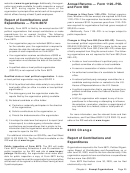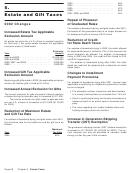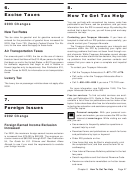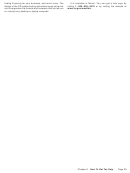Publication 553 - Highlights Of 2002 Tax Changes Page 19
ADVERTISEMENT
For all filing statuses other than married filing separately,
compensation paid or accrued during the year to your
the upper and lower limits of the phaseout range increased
eligible employees participating in the plan. Compensation
for figuring the deduction for contributions includes elective
by $1,000.
deferrals.
New Rollovers from a Traditional IRA
Defined benefit plans. The maximum deduction for con-
tributions can be as much as the plan’s unfunded current
You can roll over, tax free, a distribution from your tradi-
liability.
tional IRA into a qualified plan, including a deferred com-
pensation plan of a state or local government (section 457
Elective deferrals. Elective deferrals will not be subject to
plan) and a tax-sheltered annuity (section 403(b) plan).
the deduction limits that apply to qualified plans. Also,
The part of the distribution that you can roll over is the part
elective deferrals are not taken into account when figuring
that would otherwise be taxable (includible in your in-
the amount you can deduct for employer contributions that
come). Qualified plans may, but are not required to, accept
are not elective deferrals.
such rollovers.
Elective Deferrals (401(k) Plans)
Rollovers of Distributions from Employer
The limit on elective deferrals for participants in 401(k)
Plans
plans (excluding SIMPLE plans) increases for tax years
beginning after 2001, as follows.
You can roll over both the taxable and nontaxable part of a
distribution from a qualified plan into a traditional IRA. If
Year
Limit
you have both deductible and nondeductible contributions
in your IRA, you will have to keep track of your basis so you
2002 . . . . . . . . . . . . . . . . . . . . . . . . . . . . . . .
$11,000
will be able to determine the taxable amount once distribu-
2003 . . . . . . . . . . . . . . . . . . . . . . . . . . . . . . .
12,000
tions from the IRA begin.
2004 . . . . . . . . . . . . . . . . . . . . . . . . . . . . . . .
13,000
2005 . . . . . . . . . . . . . . . . . . . . . . . . . . . . . . .
14,000
2006 and later years . . . . . . . . . . . . . . . . . . .
15,000
Change of Method Allowed in Computing
Note. The $15,000 limit is subject to adjustment after 2006 for
IRA Distributions
cost-of-living increases.
Generally, if you begin receiving distributions from your
Catch-up contributions. For tax years beginning after
traditional IRA before you are age 59
1
/
, you must pay a
2
2001, a plan can permit participants who are age 50 or
10% additional tax on the part of those distributions that
older at the end of the calendar year to make catch-up
you must include in income. However, if you began receiv-
contributions, as follows.
ing substantially equal periodic payments using a certain
method, you generally do not have to pay the additional tax
Year
Catch-Up Limit
unless you change methods. You may now be able to
2002 . . . . . . . . . . . . . . . . . . . . . . . . . . .
$1,000
change the method you use to calculate your distribution
2003 . . . . . . . . . . . . . . . . . . . . . . . . . . .
2,000
from the “fixed amortization method” or the “fixed annui-
2004 . . . . . . . . . . . . . . . . . . . . . . . . . . .
3,000
tization method” to the required minimum distribution
2005 . . . . . . . . . . . . . . . . . . . . . . . . . . .
4,000
method and still not have to pay the additional tax.
2006 and later years . . . . . . . . . . . . . . .
5,000
Note. The $5,000 limit is subject to adjustment after 2006 for
cost-of-living increases.
Required Minimum Distributions
The catch-up contribution a participant can make for a
When determining the amount of a required minimum
year cannot exceed the lesser of the following amounts.
distribution for 2002, you can use the rules in either the
•
The catch-up contribution limit.
2001 or 2002 edition of Publication 590.
•
The excess of the participant’s compensation over
Qualified Plans
the elective deferrals that are not catch-up contribu-
tions.
The following changes apply to qualified plans. For more
information, see Publication 560, Retirement Plans for
Limits on Contributions and Benefits
Small Business.
For years ending after 2001, the maximum annual benefit
for a participant under a defined benefit plan increases to
Deduction Limits Changed
the lesser of the following amounts.
For years beginning after 2001, the following deduction
•
100% of the participant’s average compensation for
limits apply.
his or her highest 3 consecutive calendar years.
•
Profit-sharing plans. The maximum deduction for contri-
$160,000 (subject to cost-of-living increases after
butions to a profit-sharing plan is increased to 25% of the
2002).
Chapter 3 IRAs and Other Retirement Plans
Page 19
ADVERTISEMENT
0 votes
Related Articles
Related forms
Related Categories
Parent category: Financial
 1
1 2
2 3
3 4
4 5
5 6
6 7
7 8
8 9
9 10
10 11
11 12
12 13
13 14
14 15
15 16
16 17
17 18
18 19
19 20
20 21
21 22
22 23
23 24
24 25
25 26
26 27
27 28
28 29
29 30
30 31
31








